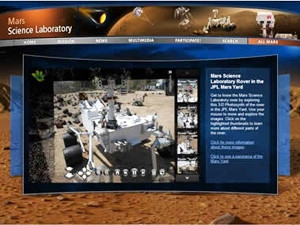
A charter of the National Aeronautics and Space Administration (NASA) is to educate the public and inspire students.
NASA hosts a Web site for the purpose of generating public awareness about the Mars Science Laboratory rover known as Curiosity. The Mars team wanted to add even greater interactivity to let people explore the new rover and to give them a realistic feeling of the rover's scale and testing environment.
NASA worked with Microsoft to create an online three-dimensional view of a full-scale model of Curiosity by using Microsoft Photosynth technology and Microsoft Silverlight, the cross-browser plug-in. Now, by using Silverlight, NASA can let the public explore the new Mars Science Laboratory and generate greater awareness about the project, while enabling people to enjoy virtual experiences that bring the universe to their desktops.
Taking people to places where most never go: that's a real challenge for NASA. Beyond space exploration and scientific discovery, NASA's charter is to educate the public and inspire students. New Web technologies play a critical role in fulfilling that mandate.
NASA wanted to engage people's interest in Curiosity. Developed at the NASA Jet Propulsion Laboratory (JPL), in Pasadena, California, this new rover is roughly the size of a small truck and carries a bevy of scientific equipment that will expand on the work of its successful predecessor rovers, Sojourner, Spirit and Opportunity. Able to travel much farther than previous rovers, Curiosity will assess whether the Martian environment ever supported microbial life.
NASA already hosts a sophisticated Web site dedicated to generating public awareness about Curiosity, where it features an impressive portfolio of still images, online videos and links to social networking components. However, the Mars team wanted to add even greater interactivity to let people explore the new rover for themselves. They wanted to give people a realistic feeling of the rover's scale and the actual testing environment, which is hard to do if not seeing it in person.
Case study courtesy of Microsoft. To read the full article, click here.
Share